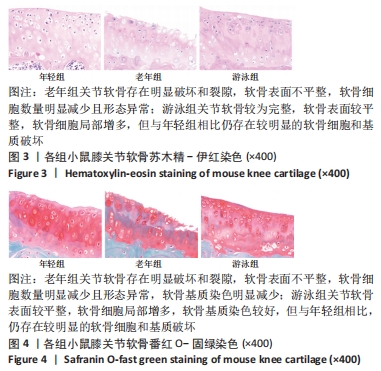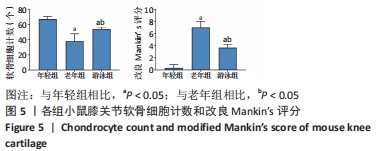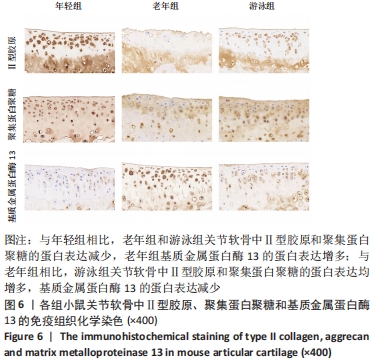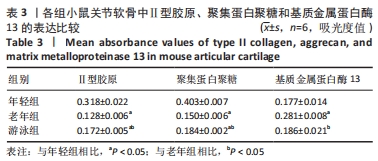[1] KATZ JN, ARANT KR, LOESER RF. Diagnosis and Treatment of Hip and Knee Osteoarthritis: A Review. JAMA. 2021;325(6):568-578.
[2] CORYELL PR, DIEKMAN BO, LOESER RF. Mechanisms and therapeutic implications of cellular senescence in osteoarthritis. Nat Rev Rheumatol. 2021;17(1):47-57.
[3] ZENG C, DUBREUIL M, LAROCHELLE MR, et al. Association of Tramadol With All-Cause Mortality Among Patients With Osteoarthritis. JAMA. 2019;321(10):969-982.
[4] LIAO Y, REN Y, LUO X, et al. Interleukin-6 signaling mediates cartilage degradation and pain in posttraumatic osteoarthritis in a sex-specific manner. Sci Signal. 2022;15(744):eabn7082.
[5] ZHENG L, ZHANG Z, SHENG P, et al. The role of metabolism in chondrocyte dysfunction and the progression of osteoarthritis.Ageing Res Rev. 2021;66:101249.
[6] LIN J, JIA S, ZHANG W, et al. Recent Advances in Small Molecule Inhibitors for the Treatment of Osteoarthritis. J Clin Med. 2023;12(5): 1986.
[7] 刘静. 中国老年膝关节骨关节炎诊疗及智能矫形康复专家共识[J]. 临床外科杂志,2019,27(12):1105-1110.
[8] FERNANDES L, HAGEN KB, BIJLSMA JW, et al. EULAR recommendations for the non-pharmacological core management of hip and knee osteoarthritis. Ann Rheum Dis. 2013;72(7):1125-1135.
[9] ARDEN NK, PERRY TA, BANNURU RR, et al. Non-surgical management of knee osteoarthritis: comparison of ESCEO and OARSI 2019 guidelines.Nat Rev Rheumatol. 2021;17(1):59-66.
[10] BOWDEN JL, HUNTER DJ, DEVEZA LA, et al. Core and adjunctive interventions for osteoarthritis: efficacy and models for implementation. Nat Rev Rheumatol. 2020;16(8):434-447.
[11] KOLASINSKI SL, NEOGI T, HOCHBERG MC, et al. 2019 American College of Rheumatology/Arthritis Foundation Guideline for the Management of Osteoarthritis of the Hand, Hip, and Knee. Arthritis Rheumatol. 2020;72(2):220-233.
[12] DANNAWAY J, NEW CC, NEW CH, et al. Aquatic exercise for osteoarthritis of the knee or hip (PEDro synthesis). Br J Sports Med. 2017;51(16):1233-1234.
[13] BARTELS EM, JUHL CB, CHRISTENSEN R, et al. Aquatic exercise for the treatment of knee and hip osteoarthritis. Cochrane Database Syst Rev. 2016;3(3):CD005523.
[14] AL-HASHEM F, EL KARIB AO, BIN-JALIAH I, et al. Exercise protects against insulin-dependent diabetes-induced osteoarthritis in rats: A scanning electron microscopy study. Ultrastruct Pathol. 2017;41(3):252-257.
[15] HSIEH YL, YANG CC. Early intervention of swimming exercises attenuate articular cartilage destruction in a rat model of anterior cruciate ligament and meniscus knee injuries. Life Sci. 2018;212:267-274.
[16] XUE T, NING K, YANG B, et al. Effects of Immobilization and Swimming on the Progression of Osteoarthritis in Mice.Int J Mol Sci. 2022;24(1): 535.
[17] ZHANG J, QI B, LIU M, et al. Influence of swimming exercise on the expression of apoptotic gene caspase-3 in chondrocytes in osteoarthritis. Am J Transl Res. 2021;13(4):2511-2517.
[18] MARTINS GA, DEGEN AN, ANTUNES FTT, et al. Benefits of electroacupuncture and a swimming association when compared with isolated protocols in an osteoarthritis model. J Tradit Complement Med. 2021;12(4):375-383.
[19] DA SILVA L A, THIRUPATHI A, COLARES MC, et al. The effectiveness of treadmill and swimming exercise in an animal model of osteoarthritis. Front Physiol. 2023;14:1101159.
[20] DAANS M, LUYTEN FP, LORIES RJ. GDF5 deficiency in mice is associated with instability-driven joint damage, gait and subchondral bone changes. Ann Rheum Dis. 2011;70(1):208-213.
[21] AIGNER T, COOK JL, GERWIN N, et al. Histopathology atlas of animal model systems – overview of guiding principles. Osteoarthritis Cartilage. 2010;18: S2-S6.
[22] ALVES-SIMÕES M. Rodent models of knee osteoarthritis for pain research. Osteoarthritis Cartilage. 2022;30(6):802-814.
[23] KAYA S, BAILEY KN, SCHURMAN CA, et al. Bone-cartilage crosstalk informed by aging mouse bone transcriptomics and human osteoarthritis genome-wide association studies. Bone Rep. 2022;18: 101647.
[24] ZHANG X, DENG XH, SONG Z, et al. Matrix Metalloproteinase Inhibition With Doxycycline Affects the Progression of Posttraumatic Osteoarthritis After Anterior Cruciate Ligament Rupture: Evaluation in a New Nonsurgical Murine ACL Rupture Model.Am J Sports Med. 2020;48(1):143-152.
[25] ORHAN C, TUZCU M, DURMUS AS, et al. Protective effect of a novel polyherbal formulation on experimentally induced osteoarthritis in a rat model. Biomed Pharmacother. 2022;151:113052.
[26] RUI F, JIAWEI K, YUNTAO H, et al. Undenatured type II collagen prevents and treats osteoarthritis and motor function degradation in T2DM patients and db/db mice.Food Funct. 2021;12(10):4373-4391.
[27] ROBINSON WH, LEPUS CM, WANG Q, et al. Low-grade inflammation as a key mediator of the pathogenesis of osteoarthritis. Nat Rev Rheumatol. 2016;12(10):580-592.
[28] LOESER RF, COLLINS JA, DIEKMAN BO. Ageing and the pathogenesis of osteoarthritis. Nat Rev Rheumatol. 2016;12(7):412-420.
[29] GREENE MA,LOESER RF.Aging-related inflammation in osteoarthritis.Osteoarthritis Cartilage. 2015;23(11):1966-1971.
[30] TALAHALLI R, ZARINI S, TANG J, et al. Leukocytes regulate retinal capillary degeneration in the diabetic mouse via generation of leukotrienes. J Leukoc Biol. 2013;93(1):135-143.
[31] 颜春鲁, 安方玉, 蒋国凤, 等. 藤黄健骨胶囊对膝骨关节炎大鼠血细胞变化及炎症因子表达的影响[J]. 生物学杂志,2020,37(6):84-87.
[32] KLEIN JC, KEITH A, RICE SJ, et al. Functional testing of thousands of osteoarthritis-associated variants for regulatory activity. Nat Commun. 2019;10(1):2434.
[33] BERGHOLT MS, ST-PIERRE JP, OFFEDDU GS, et al. Raman Spectroscopy Reveals New Insights into the Zonal Organization of Native and Tissue-Engineered Articular Cartilage. ACS Cent Sci. 2016;2(12):885-895.
[34] BORTOLUZZI A, FURINI F, SCIRÈ CA. Osteoarthritis and its management - Epidemiology, nutritional aspects and environmental factors. Autoimmunity Rev. 2018;17(11):1097-1104.
[35] KIM TH, YOO JY, CHOI KC, et al. Loss of HDAC3 results in nonreceptive endometrium and female infertility. Sci Transl Med. 2019;11(474): eaaf7533.
[36] RAHMATI M, NALESSO G, MOBASHERI A, et al. Aging and osteoarthritis: Central role of the extracellular matrix. Ageing Res Rev. 2017;40:20-30.
[37] Poole AR, Kobayashi M, Yasuda T, et al. Type II collagen degradation and its regulation in articular cartilage in osteoarthritis. Ann Rheum Dis. 2002;61 Suppl 2(Suppl 2):ii78-81.
[38] GOOLJARSINGH LT, LAKDAWALA A, COPPO F, et al. Characterization of an exosite binding inhibitor of matrix metalloproteinase 13. Protein Science. 2007;17(1): 66-71.
[39] HU Q, ECKER M. Overview of MMP-13 as a Promising Target for the Treatment of Osteoarthritis. Int J Mol Sci. 2021;22(4):1742.
[40] AGARWAL P, LEE H PYO, SMERIGLIO P, et al. A dysfunctional TRPV4–GSK3β pathway prevents osteoarthritic chondrocytes from sensing changes in extracellular matrix viscoelasticity.Nat Biomed Eng. 2021; 5(12):1472-1484.
[41] CAO Z, LIU W, QU X, et al. miR-296-5p inhibits IL-1β-induced apoptosis and cartilage degradation in human chondrocytes by directly targeting TGF-β1/CTGF/p38MAPK pathway.Cell Cycle. 2020;19(12):1443-1453. |









